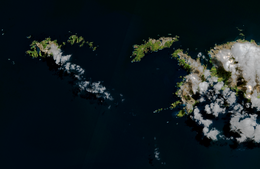Willis Islands
54°0′S38°11′W/ 54.000°S 38.183°W
 Satellite image of Willis Islands to the left | |
 Location of Willis Islands | |
| Geography | |
|---|---|
| Location | South Atlantic Ocean |
| Coordinates | 54°0′S38°11′W/ 54.000°S 38.183°W |
| Archipelago | South Georgia Islands |
| Administration | |
| Overseas Territory | South Georgia and the South Sandwich Islands |
TheWillis Islandsare a small archipelago to the west ofSouth Georgia Islandin theSouth Georgia Islands.They are 2 miles (3.2 km) west ofBird Island,separated by theStewart Strait.[1][2]They were discovered on 14 January 1775 by CaptainJames Cookand named for Cook's midshipmanThomas Willis,the crew member who first sighted them.[1]The Willis Islands were charted in greater detail and individually named byDiscovery Investigations(DI) personnel between 1926 and 1930.[3][4]
Geography
[edit]Main Island
[edit]
The archipelago's largest island is called Main Island, so-named because at 1.7 mi (2.7 km) long and 1,800 ft (550 m) high, it is the principal island in the group.[3]
Its southwestern point is called Johannesen Point, originally "All Johannesens Point," likely by DI personnel. Following a survey of the island in 1951–52, theSouth Georgia Survey(SGS) reported that the cumbersome name was seldom used locally. On that basis, theUK Antarctic Place-Names Committee(UK-APC) recommended the present shortened form of the name.[5]
West and south of Main Island
[edit]West of Main Island are several named rocks, groups of rocks, and shoals.
Acorn Rock rises 20 m (66 ft) above sea level, 0.35 mi (0.6 km) northwest of Main Island. The descriptive name was applied during ahydrographic surveyfromHMSOwen(K640)in 1960–61.[6]1.5 nmi (3 km) northwest of Main Island is Holgate Shoal, an area ofshoalsnamed by the UK-APC for Able SeamanRalph A. Holgateof theOwen,which charted the shoal in 1961.[7]A pair of rocks named the Tiger Rocks are located 1.5 nmi (3 km) west of Main Island, southwest of the shoal. The descriptive name was applied during the surveys from theOwen.[8]The westernmost point of the Willis Islands is a group of three barren rocks called the Ramp Rocks, 2.5 nmi (4.6 km) northwest of Johannesen Point on Main Island. The largest of them was originally calledlaavebrua( "threshing floor ramp" ) by Norwegian whalers, but to avoid confusion withLåvebrua Island,UK-APC named the trio the Ramp Rocks.[9]
One nmi (2 km) west-southwest of the south end of Main Island is a small group of rocks named the Bryde Rocks. Positioned by the SGS between 1951 and 1957, the group was named by UK-APC forThorleif Bryde,a gunner of theSouth Georgia Whaling Co.[10]
Pugh Shoal is an area of shoal 1.5 nmi (2.8 km; 1.7 mi) south of Main Island, named by UK-APC for Able SeamanPeter J. Pughof theOwen,which charted this shoal in 1961.[11]
East of Main Island
[edit]Heron Passage separates Main Island from Vaughan Island close to the east, and Trinity Island 0.7 mi (1.1 km) to the northeast.[12][4][13]The existence of the passage was first reported in the 1930s, and confirmed byHMSOwenduring ahydrographic surveyof the area in 1961. It was named by UK-APC after one of theOwen's survey motor boats, theHeron.[12]
Vaughan Island is a small, conicaltussock-covered island close east of Main Island. It was named by UK-APC for Lieutenant CommanderHugh L.F. Vaughan,Royal Navy,First Lieutenantof theOwen.[4]The much larger Trinity Island was so-named by DI because it has three peaks.[13]To the southeast are a pair of small tussock-covered islands called the Verdant Islands, descriptively named "Verdant Island" by DI. The name was amended in 1985 to reflect that there were actually two islands there.[14]To the east is Hall Island, small, steep-sided, and tussock-covered. It was named by UK-APC after CommanderGeoffrey P.D. Hallof theRoyal Navy,Commanding Officerof theOwen.[15]The easternmost island in the group is Proud Island, a small, relatively high, tussock-covered island, rising to apeakat its northern end. It was descriptively named by UK-APC, the expression "standing proud" in naval parlance being the equivalent of "sticking up."[16]
-
Vaughan Island
-
Trinity Island
-
Verdant Islands
-
Hall Island
-
Proud Island
Fauna
[edit]The Willis Islands are a significant breeding ground forAntarctic fur seals.[17]
See also
[edit]- Composite Gazetteer of Antarctica
- List of Antarctic and subantarctic islands
- Scientific Committee on Antarctic Research(SCAR)
- Territorial claims in Antarctica
References
[edit]- ^ab"Willis Islands".Geographic Names Information System.United States Geological Survey,United States Department of the Interior.Retrieved13 May2019.
- ^"Stewart Strait".Geographic Names Information System.United States Geological Survey.Retrieved13 May2019.
- ^ab"Main Island".Geographic Names Information System.United States Geological Survey.Retrieved13 May2019.
- ^abc"Vaughan Island".Geographic Names Information System.United States Geological Survey.Retrieved13 May2019.
- ^"Johannesen Point".Geographic Names Information System.United States Geological Survey.Retrieved13 May2019.
- ^"Acorn Rock".Geographic Names Information System.United States Geological Survey.Retrieved13 May2019.
- ^"Holgate Shoal".Geographic Names Information System.United States Geological Survey.Retrieved13 May2019.
- ^"Tiger Rocks".Geographic Names Information System.United States Geological Survey.Retrieved13 May2019.
- ^"Ramp Rocks".Geographic Names Information System.United States Geological Survey.Retrieved13 May2019.
- ^"Bryde Rocks".Geographic Names Information System.United States Geological Survey.Retrieved13 May2019.
- ^"Pugh Shoal".Geographic Names Information System.United States Geological Survey.Retrieved13 May2019.
- ^ab"Heron Passage".Geographic Names Information System.United States Geological Survey.Retrieved13 May2019.
- ^ab"Trinity Island".Geographic Names Information System.United States Geological Survey.Retrieved13 May2019.
- ^"Verdant Islands".Geographic Names Information System.United States Geological Survey.Retrieved13 May2019.
- ^"Hall Island".Geographic Names Information System.United States Geological Survey.Retrieved13 May2019.
- ^"Proud Island".Geographic Names Information System.United States Geological Survey.Retrieved13 May2019.
- ^Kerry, K. R.; Hempel, G. (6 December 2012).Antarctic Ecosystems: Ecological Change and Conservation.Springer Science & Business Media.ISBN9783642840746.
Further reading
[edit]- Stonehouse, B (ed.)Encyclopedia of Antarctica and the Southern Oceans(2002,ISBN0-471-98665-8)
![]() This article incorporatespublic domain materialfrom websites or documents of theUnited States Geological Survey.
This article incorporatespublic domain materialfrom websites or documents of theUnited States Geological Survey.





